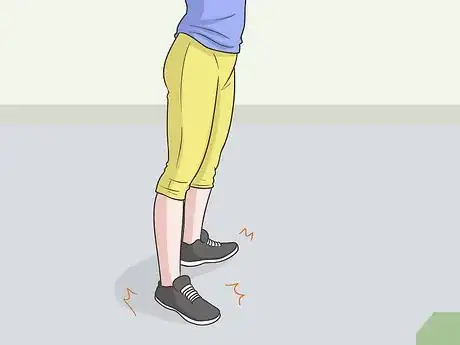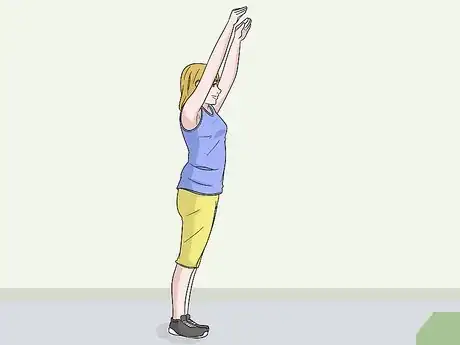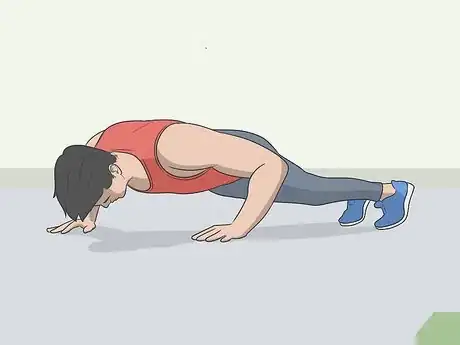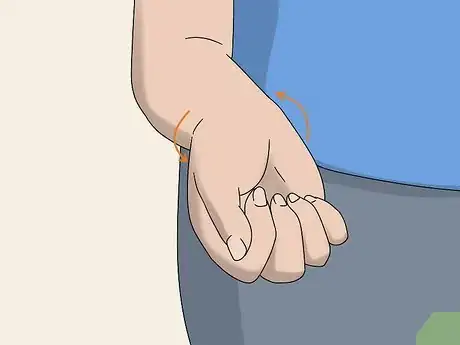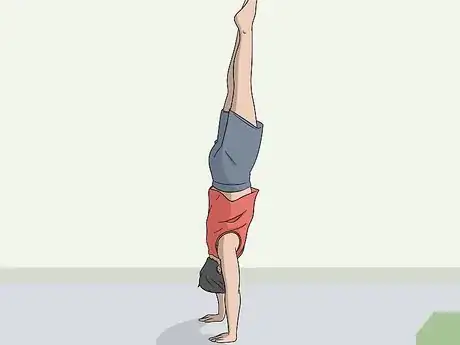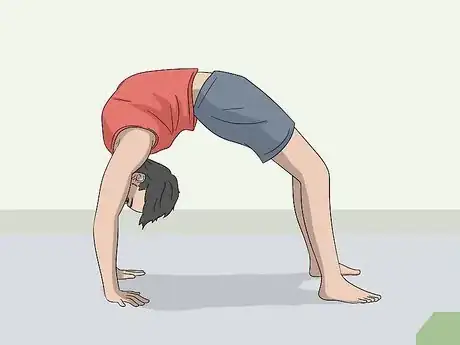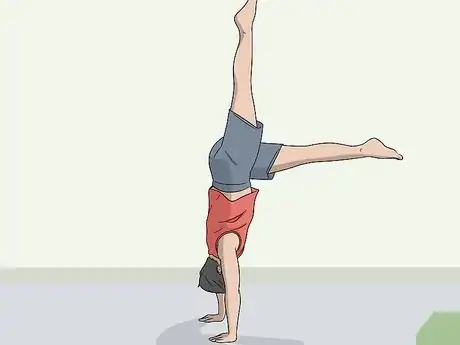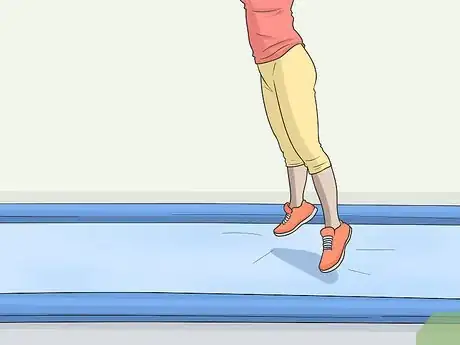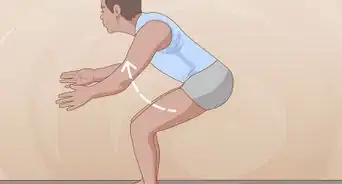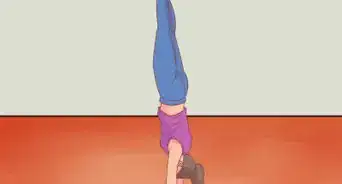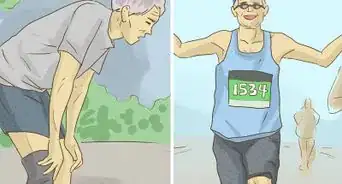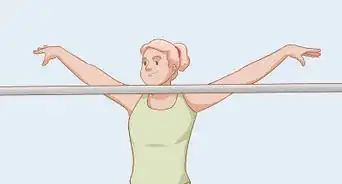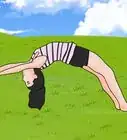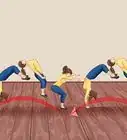This article was co-authored by Tanya Berenson and by wikiHow staff writer, Sophia Latorre. Tanya Berenson is a Gymnastics Instructor and the General Manager of the Los Angeles School of Gymnastics. With over 25 years of professional gymnastics experience, Tanya has also served as a consultant to USA Gymnastics, has served as the USA World Maccabi Games Head Coach, USA Gymnastics Meet Director, and RAS counselor. She holds a B.Ed. in Early Childhood Development from the University of California, Los Angeles.
There are 9 references cited in this article, which can be found at the bottom of the page.
This article has been viewed 1,256,827 times.
The back handspring is a basic building block for many gymnastics or cheerleading routines. If you want to do a back handspring, you should already have built up your upper body strength, especially in your arms and shoulders. Before doing a back handspring, you should be comfortable doing a backbend, handstand, and back walkover. Then, practice with a spotter and on a trampoline until you feel confident doing a back handspring on the floor by yourself.
Steps
How to Perfect Your Form
-
1Bend your hips forward and swing your arms down. To begin, stand up straight with your arms extended by your ears. Then, sit back, like you're going to lean back in a chair. As you do this, swing your arms down and back behind you. Your knees should be directly over your feet, not positioned in front of your feet, or you won't generate enough momentum to land on your hands.EXPERT TIP
If you're not sure that you're ready, you should always start with a spotter, practice on a trampoline, or try it into a soft pit.
Rosalind Lutsky worked as a gymnastics coach at SB Gymnastics at Stanford University, coaching children from ages 5-12 years old during her time as a Stanford student. She was a competitive gymnast growing up, and competed for her local gymnastics team in Minnesota.
Rosalind Lutsky
Former Gymnastics Coach Rosalind Lutsky
Rosalind Lutsky
Former Gymnastics Coach -
2Push through your toes and lift your arms up. Swing your arms forward until they reach over your head. Follow your hands with your eyes. At the same time, push through your toes to gain momentum and launch your body backward. Keep your legs together and your core muscles tight.[1]Advertisement
-
3Continue to fall backwards without arching your back too much. Arching your back too much is called undercutting and will not only make your back handspring look less pretty, but it could also injure your back. As you fall, let your legs continue to drive you upward and backward. Point your toes and extend through your ankles.[2]
- Make sure you keep your head back between your arms as they approach the floor.
-
4Plant your hands on the floor. Reach for the floor as you fall backwards and make sure to keep your body arched. Keep your arms straight so you don't hit your head on the floor. Your fingers should be pointing up and away from your face with your palms flat on the ground. Let the momentum of your legs, with your lower body still following, carry you over.[3]
- When your hands are planted on the floor, use the pads of your hands and fingers, your arms, and your shoulders for support. Don't put all of your weight and pressure on your hands.
EXPERT TIPRosalind Lutsky worked as a gymnastics coach at SB Gymnastics at Stanford University, coaching children from ages 5-12 years old during her time as a Stanford student. She was a competitive gymnast growing up, and competed for her local gymnastics team in Minnesota.Former Gymnastics Coach
 Rosalind Lutsky
Rosalind Lutsky
Former Gymnastics CoachThis is where your handstand form really comes into play. Rosalind Lutsky, former gymnastics coach, adds: “Before working on a backhandspring, make sure you've perfected your handstand, along with other basic moves that help you develop core and arm strength.”
-
5Swing your legs over your head. Snap your legs over your head and around to the floor, with your feet together and your toes pointed. Don't lock your knees, but keep your legs almost straight. Keep your shoulders in line with your hands.[4]EXPERT TIPRosalind Lutsky worked as a gymnastics coach at SB Gymnastics at Stanford University, coaching children from ages 5-12 years old during her time as a Stanford student. She was a competitive gymnast growing up, and competed for her local gymnastics team in Minnesota.Former Gymnastics Coach

 Rosalind Lutsky
Rosalind Lutsky
Former Gymnastics CoachRosalind Lutsky, former gymnastics coach, adds: “After your hands hit the ground, you want to push off and get your chest up, to help you stick the landing. It can be useful to practice that last part by going into a handstand and trying to push yourself off the ground and land on two feet."
-
6Plant your feet on the floor. Continue by swinging your legs and feet over and snapping them down firmly toward the floor. Keep your upper body straight as your toes approach the floor.[5]
-
7Pop up. To finish the back handspring, land with your legs slightly bent and pop up to release your momentum. Bring your arms straight in front of you and then raise them up over your head.[6]
- Don't be discouraged if you don't get it right immediately. Work with a spotter until you feel comfortable enough to do it on your own. With enough hard work, you'll have a neat and smoothly-executed back handspring in no time.
How to Warm up and Stretch
-
1Warm up. You shouldn’t attempt a back handspring without warming up, as it makes you more likely to get hurt. Jog a few laps around the gym or track to get your blood flowing. You can also jump rope for a couple minutes, or do jumping jacks, lunges, or push ups.
-
2Stretch your wrists and ankles. Roll your wrists and ankles clockwise and counterclockwise five times each. Practice pointing and flexing your feet ten times each.
- To stretch your wrists, get on your knees and place your hands on the ground palms-down, with the fingers pointed at you. Then, pull back on your arms to feel a deep stretch in your wrists.[7]
- To stretch your ankles, sit on a chair and put an exercise band or jump rope around one foot. Pull on the band with your hands and push against the force with your ankle. Repeat with the other foot.[8]
-
3Practice your handstands. Begin by standing straight up with your arms over your head. Let your body fall forward and place your palms firmly on the ground. Kick one leg up and allow the other leg to follow naturally. Tighten your core and buttock muscles to keep yourself in the upright position.[9]
- Try walking on your hands to build your strength. Put your hands on the ground parallel to each other about 1.5 feet (0.46 m) in front of your chest and walk your legs backward up a solid wall or door. Then practice moving your hands left to right and right to left. Keep your core tight and your head down.
-
4Do a backbend. Start by standing up straight with your legs shoulder-width apart and your arms extended by your ears. Look up at the ceiling, point your fingers, and push your hips forward. Slowly bend backward, keeping your arms locked. Plant your hands firmly on the ground and keep your feet in place. Lower yourself slowly to the ground after holding the backbend for 15-30 seconds.[10]
- If you're a beginner, practice on a wall. Tighten your core, tuck your head in, and place your hands behind you on a wall. Walk your hands up and down the wall until you feel comfortable with the movement.
-
5Do a back walkover. Once you’re comfortable doing a backbend, practice doing a walkover. When you’re fully in the backbend position, lift one leg off the ground and point your toes. Swing that leg around toward your head and push your other leg off the ground and allow it to follow naturally.[11]
- Practice doing kicks on each leg from a bridge position until you can fully kick both legs over.
How to Get Comfortable with the Movements
-
1Use a soft mat. To get comfortable going backwards you should use a soft surface to prevent injury of any kind. Find a cushy, soft mat and practice jumping backwards onto it. Swing your arms back the same way you would when doing a back handspring to get comfortable with the movements.[12]
-
2Get a spotter. Make sure that when you try to do a back handspring for the first time, you have a spotter, like a coach or gymnastics teacher, to help you. This will prevent you from hurting yourself and will give you the confidence you need to successfully do the back handspring. The spotter should place one hand on your lower back and one hand under your thighs to help you flip backwards. [13]
- Make sure your spotter can sustain your weight and that they know how to properly spot.
-
3Try your back handspring on a trampoline. If you're not feeling confident about backwards movements, or you're a beginner to this move, start off on a trampoline. This way, you can gain your confidence until you're ready to go and do it on a harder surface like grass without the risk of injury.[14]
Community Q&A
-
QuestionHow can I land my aerial without being too low to the ground?
 Community AnswerFirst, make sure that your run up isn't too long because you can lose some power that way. Also, swing your legs around very quickly. This way, you will have some power left to bring you back up.
Community AnswerFirst, make sure that your run up isn't too long because you can lose some power that way. Also, swing your legs around very quickly. This way, you will have some power left to bring you back up. -
QuestionHow do you know that you are strong enough to do a back handspring?
 Community AnswerYou really can't tell until you try it - the stronger your arms are, the straighter your arms will be once you hit the floor. If your arms are really bent and droopy when you hit the floor, that means you may have to work on your arm strength. In general, the ability to do comfortable push-ups, pull-ups, and basic gymnastics moves is essential.
Community AnswerYou really can't tell until you try it - the stronger your arms are, the straighter your arms will be once you hit the floor. If your arms are really bent and droopy when you hit the floor, that means you may have to work on your arm strength. In general, the ability to do comfortable push-ups, pull-ups, and basic gymnastics moves is essential. -
QuestionHow do I get over the fear of going backwards into the handspring?
 Community AnswerLearn how to go from standing into a bridge (or back bend - whatever you call it) try doing this as quickly as you can. This should to overcome your fear. Also, doing it with someone you trust or your best friend spotting should help.
Community AnswerLearn how to go from standing into a bridge (or back bend - whatever you call it) try doing this as quickly as you can. This should to overcome your fear. Also, doing it with someone you trust or your best friend spotting should help.
Warnings
- Don't try this at home if you don’t have any experience, unless a trainer or professional gymnast is around to spot you.⧼thumbs_response⧽
- Without the guidance of a professional instructor, attempting a back handspring can result in serious injury.⧼thumbs_response⧽
References
- ↑ http://www.justtheskills.com/index.php?tutorial=back-handspring
- ↑ http://www.justtheskills.com/index.php?tutorial=back-handspring
- ↑ http://www.justtheskills.com/index.php?tutorial=back-handspring
- ↑ http://www.justtheskills.com/index.php?tutorial=back-handspring
- ↑ http://www.justtheskills.com/index.php?tutorial=back-handspring
- ↑ http://www.justtheskills.com/index.php?tutorial=back-handspring
- ↑ https://breakingmuscle.com/fitness/3-stretches-to-help-achy-wrists-and-prevent-carpal-tunnel
- ↑ http://www.aofas.org/footcaremd/how-to/foot-injury/Pages/How-to-Ankle-Sprain-Strengthening-Exercises.aspx
- ↑ https://gmb.io/handstand/
About This Article
Before you try to do a back handspring, make sure you're comfortable doing a backbend, handstand, and back walkover. Then, once you're able to do those moves, find a spotter to hold your lower back and thighs while you practice doing a back handspring so it's easier. Also, try to practice on a trampoline when you're first starting out since it will help you get a higher jump and reduce your risk of injury. To learn how to do a back handspring step by step, keep reading!





